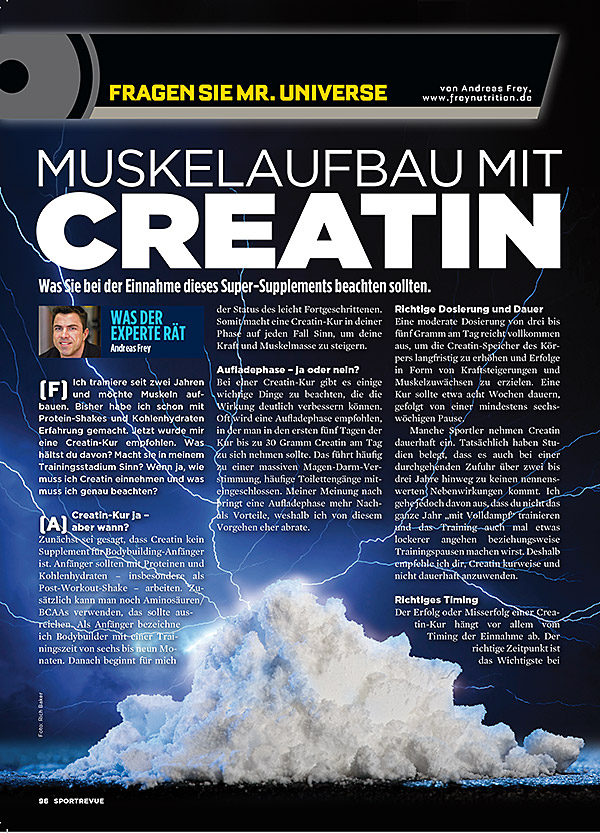WHAT TO CONSIDER WHEN TAKING THIS SUPER SUPPLEMENT.
ANSWER

CREATINE CURE: YES, BUT WHEN?
First of all, it should be said that CREATINE is not a supplement for bodybuilding beginners. Beginners should work with proteins and carbohydrates - especially as a post-workout shake. In addition, you can also use amino acids/BCAAs, that should be enough. I consider bodybuilders who have been training for less than six months to be beginners. After that, I consider them to be slightly advanced. So a creatine course definitely makes sense in your phase to increase your strength and muscle mass.CHARGING PHASE: YES OR NO?
There are a few important things to consider when taking a creatine treatment that can significantly improve the effect. A loading phase is often recommended, in which you should take up to 30 grams of creatine a day for the first five days of the treatment. This often leads to severe gastrointestinal upset, including frequent trips to the toilet. In my opinion, a loading phase has more disadvantages than advantages, which is why I would advise against this approach.THE CORRECT DOSAGE AND DURATION
A moderate dosage of three to five grams per day is sufficient to increase the body's creatine stores in the long term and achieve success in the form of increased strength and muscle growth. A course of treatment should last around eight weeks, followed by a break of at least six weeks. Some athletes take creatine on a long-term basis. In fact, studies have shown that there are no significant side effects even with continuous intake over two to three years.However, I assume that you won't be training "at full steam" all year round and that you will also take it easy or take breaks from training. That's why I recommend that you use creatine as a course of treatment and not permanently.
THE RIGHT TIMING
The success or failure of a creatine treatment depends primarily on the timing of the intake. The right time is the most important thing when using creatine. It should be taken at the exact time when the body can transport the most nutrients into the muscle cells. This time is particularly good immediately after training: the so-called anabolic window. The glycogen stores are used up by the workout and the body is practically crying out for nutrients.A post-workout drink makes the most sense at this point. 80 grams MALTO 95 (Maltodextrin), 50 grams TRIPLE WHEY (quickly available protein), eight capsules ANABOLIC BCAA + (branched chain amino acids) and three to five grams of creatine would be the optimal composition of such a shake for an 80 kg athlete. Even for athletes with a higher body weight, the dosage of three to five grams is completely sufficient; only the amount of maltodextrin and whey protein should be adjusted to the individual body weight, whereby the following rule of thumb can be used:
Whey protein = 0.5 g per kilogram of body weight
On days when you don't train, you should take creatine with a meal rich in carbohydrates. A glass of grape juice also serves the purpose and helps to release insulin due to the sugar contained in grape juice.
Although creatine is primarily a product for building muscle mass and strength and is therefore mainly used during the building phase, its use during diet phases also has some decisive advantages. For example, creatine can increase the water content of muscle cells through its strength-enhancing and osmotic effects and thus contribute to muscle maintenance.Since the short-chain carbohydrates necessary for creatine absorption would be counterproductive during diet phases, this creates a "small problem" which can, however, be quickly solved by choosing the right creatine.
This means that taking CREATINE X6 which is optimally absorbed without any simultaneous carbohydrate intake thanks to the 6-creatine ester matrix it contains. If you don't want to miss out on the positive effects of creatine while on a diet, CREATIN X6 is the creatine product of choice.
USEFUL ADDITIONS
Useful supplements to creatine intake include CHROME and on the other hand ALPHA-LIPOIC ACID Both substances optimize insulin levels and help to transport creatine into the muscles. You can read more background information about the two active ingredients in the following articles:WHAT ELSE TO CONSIDER!
During a creatine treatment, you should ensure that you drink enough fluids regularly, as creatine is excreted via the kidneys and the kidneys need fluid for the excretion and cleansing process. Increasing the individual fluid intake by one to two liters per day should be sufficient. Anyone suffering from kidney dysfunction should first discuss taking creatine with their doctor to rule out any risks. Of course, you also need to ensure that you have a balanced, protein-rich diet when using creatine in order to lay the foundation for building muscle. Two to three grams of protein per kilo of body weight, plenty of complete carbohydrates and, of course, healthy fats (vegetable oils) should be part of your diet. When training to build muscle, I think eight to twelve repetitions per set are optimal. Each workout should be limited to a maximum of 60 minutes and should be performed with up to ten sets for large muscle groups and up to six sets for small muscle groups.In the category NUTRITION and TRAINING you will find a lot of additional information that will help you build muscle.













